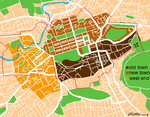Craiglockhart
Craiglockhart (/kreɪɡˈlɒkərt/; Scottish Gaelic: Creag Longairt) is a suburb in the south west of Edinburgh, Scotland, lying between Colinton to the south, Morningside to the east Merchiston to the north east and Kingsknowe to the west. The Water of Leith is also to the west.
History
The name is first recorded in 1278 as "Crag quam Stephanus Loccard miles tenuit", thus "Craig (or rock) of Loccard".[1] The family, whose name was changed to Lockhart, are credited by Historic Scotland with building Craiglockhart Castle in the fifteenth century.
The oldest "structure" in the area is the remains of a vitrified fort on the top of Wester Craiglockhart Hill, which is of prehistoric origin. This was somewhat mutilated by the addition of gun-emplacements in World War II, guarding against aerial attack. Excavations show the fort was re-occupied during Roman times. Craiglockhart Castle dates from the 15th century but is now ruined.[2] The hill is also a Site of Special Scientific Interest (SSSI) due to its diverse biological habitat.
In Victorian times the area was dominated by hospital buildings: The City Hospital (1896); Old Craig House (1565) converted to an asylum in 1878; its "modern" partner, Craighouse, purpose-built as part of the Royal Edinburgh Asylum (1889); the City Poorhouse (1867) later converted to Greenlea's Old People's Home; and Craiglockhart Hydropathic Institution, and in the years 1871-1982 this building rose dramatically above and directly overlooked the home playing grounds of Edinburgh University RFC. Craighouse and The Hydropathic are now part of the campus of Edinburgh Napier University. During the First World War, the hospital was used to house officers suffering from the symptoms of shell-shock. Invalids here included the poets Wilfred Owen and Siegfried Sassoon, who met while patients. After the war this the building served as a convent and then a theological school, before passing to the then Napier College.
The area became part of Edinburgh City in 1920 and consequently the area was developed in the 1930s, largely with bungalows and low density housing on the low-lying ground around the Wester and Easter Craiglockhart Hills.
Approximately at the boundary point between Craiglockhart and Merchiston runs the Edinburgh Suburban railway line. There was once a station just off Colinton Road, and this may return, since the line is mooted for re-opening as part of Edinburgh's future transport strategy.
Craiglockhart today is chiefly residential, with a small proportion of commercial properties, and is in general considered to be a comfortable middle-class area, with a mixture of terraced and detached villas, of a variety of ages.
Attractions and amenities
Craiglockhart Tennis Centre plays host to large international tennis competitions, with a series of well kept indoor and outdoor courts. One famous product of the centre is Andy Murray, who often trained there. On the same ground is Craiglockhart Sport And Leisure Centre which has a small boating pond (built as a curling pond in 1878).
A small cluster of commercial premises remain close to the station site, with a further group located opposite the Craiglockhart Tennis Centre. A small Tesco "Express" supermarket has been built on the site of a former petrol station adjacent to the Meggetland playing fields. The opening of this branch of Tesco was vociferously opposed by the Scottish food writer Joanna Blythman,[3] who claimed that opening the store would damage the local grocery store at Happy Valley.
There is a Craiglockhart Primary School, although this is a little to the north of Craiglockhart itself, technically within North Merchiston (though commonly described as within Polwarth or Shandon.)
References
- ↑ Lua error in package.lua at line 80: module 'strict' not found.
- ↑ Lua error in package.lua at line 80: module 'strict' not found.
- ↑ Edinburgh Evening News
External links
- Bartholomew's Chronological map of Edinburgh (1919)
- Craiglockhart Community Council
- Craiglockhart Primary School
Lua error in package.lua at line 80: module 'strict' not found.

